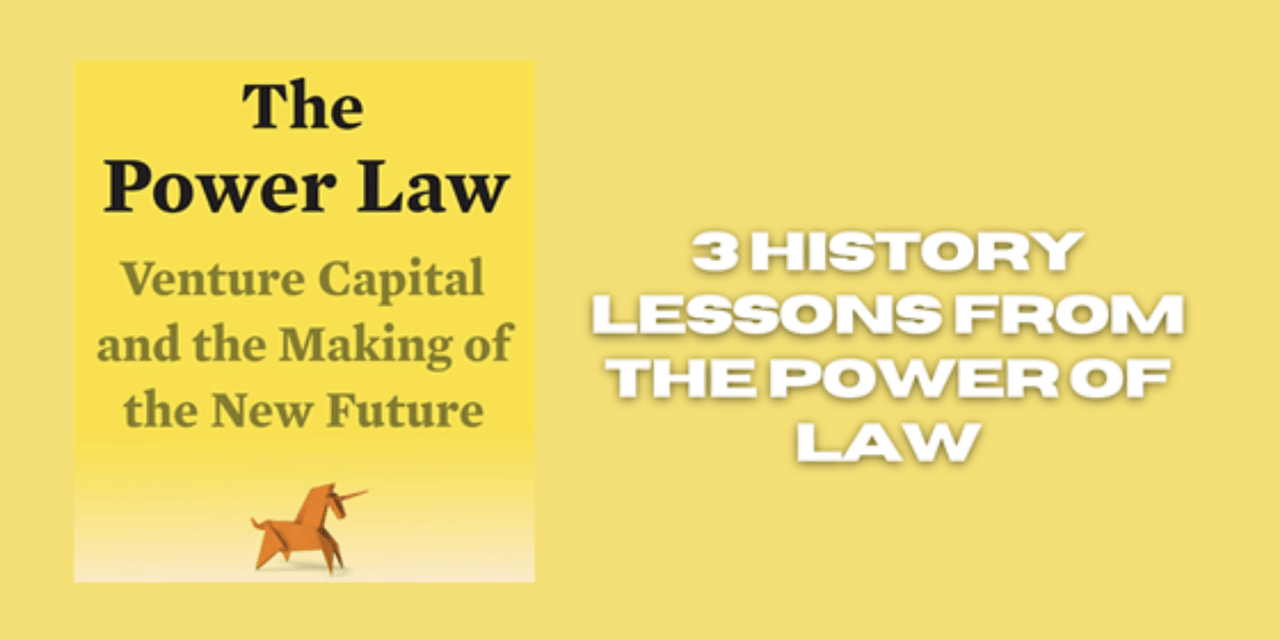Sebastian Mallaby, an English journalist and author known best for his coverage of the finance sector, has written what is sure to be one of the standout books about the technology space this year. In The Power Law, Mallaby brings an outsider’s perspective to meticulously trace the lineage of venture capital back through its earliest days and founding characters, starting with the first principles that informed the industry’s pioneers.
The very first of these is of course based on the book’s eponymous title, the power law distribution itself, which comes into effect in spaces where “winners advance at an accelerating, exponential rate, so that they explode upward far more rapidly than in a linear progression… Anytime you have outliers whose success multiplies success, you switch from the domain of the normal distribution to the land rules by the power law” (8). This belief in taking big risks to find disproportionate winners – ones that have a chance to provide outsized returns on investment – is twinned with an equally important second belief in the early history of venture capital: that these big, truly outsized winners can only emerge outside the bounds of conventional analysis – “the revolutions that will matter – the big disruptions that create [winners] – cannot be predicted based on extrapolations of past data… but emerge as a result of forces that are too difficult to forecast” (11). Between these two twinned principles, Mallaby believes, are the ports of departure for venture capitalists in their consideration, and staking of, moonshot investment opportunities, and a modality of thinking that eschews incrementalism that has come to define Silicon Valley. Lesson 1: Developing a new finance fit for tech, free of capital-F Finance principlesWhat we know as conventional wisdom in venture capital today was not also so. In fact, the earliest days of venture capital required several of the finance industry’s sacred cows to be sacrificed in rapid succession. In the early 1960s, financial professionals Arthur Rock and Tommy Davis, ostensibly bored with stable financial services careers and seeking “new growth stocks at attractive prices” (44), made a bold bet on changing how innovative technologies could receive financing. The two men, tired of the traditionally risk averse investing ethos of their profession, and believing that speculative technology investments that interested them should be able to access capital as well, set up a new limited partnership that eschewed traditional finance metrics used to determine a ‘sound’ investment. To enable this risk appetite, their key innovation was to flip the model of investment on its head – rather than identifying startups and then seeking investors, they would do the opposite: first raise capital (the fund) and render usual corporate investors unnecessary. The two founders compensated everyone, including all of their employees, with equity, another novel concept for the time, and their San Francisco based fund helped pioneer the approach to risk management that has become standard in modern venture capital: rejection of modern portfolio theory and diversification, in favour of concentrated bets on fewer companies. The result: in seven years, their initial fund of $3.4 million had returned an astonishing 22.6x and was worth $77 million. A fit-for-purpose model of finance was born. |
Lesson 2: The emergence of hands-on activism and stage-by-stage financingWhere Rock and Davis began by doing away the conventional wisdom of finance, younger investors sought to build on their early success in additive ways. In the 1970s, new venture investors who’d watched Rock and Davis succeed at deploying more capital to fewer, riskier bets, decided to go a step further: rather than “merely identifying entrepreneurs and monitoring them, the new venture capitalists actively shaped them: they told the founders whom to hire, how to sell” (59). How did this second era of VC’s enforce the type of management oversight that even Rock and Davis would have considered unthinkable just a decade earlier? By doling out capital in tranches, ensuring the entrepreneurs they invested in reached agreed milestones before they could receive the next cheque. The earliest adopters of this new activist ethos? None other than Don Valentine (Sequoia Capital) and Tom Perkins (Kleiner Perkins Caufield & Byers), now household names in venture capital. Lesson 3: The emergence of the network effect – how the venture community can fix its own errorsIn investor Peter Thiel’s famous tome on building startups, Zero to One, the concept of the network effect was popularized in the context of rapidly growing companies – it is the phenomenon whereby a product becomes intrinsically more valuable as it acquires more users. But in the earliest days of venture capital, Silicon Valley itself had to first establish its own ecosystem version of a network effect, in order to ensure that the tools and methodologies that Rock, Davis, and next wave of activist investors had established, would grow on sustainable footing and not simply disappear after a few misses. The earliest roots of this network effect thinking took place in late 1976, when Steve Jobs and Steve Wozniak could not find – even amongst the bold-betting dreamers and activist risk takers in the new VC elite – anyone to write a cheque into a new computing company they called ‘Apple’. Famously, “Tom Perkins and Eugene Kleiner refused to even meet with Steve Jobs” (82), and the rest of Silicon Valley’s new elite followed suit. Jobs and Wozniak could not even convince a single investor to take on 10% of the company for a mere $10,000. However, Silicon Valley had by this time become large enough, and developed a big enough network effect, that oversights like this could self-correct by way of the consolation prize: personal introductions. Some of the same VCs that refused to write a cheque, did help Jobs and Wozniak with several introductions, eventually leading the pair to meet the engineer Mike Markkula, who had recently retired at the age of 33 on the back of his lucrative Intel stock options (84). Markkula was not a traditional venture investor, or an investor at all. But he became Silicon Valley’s first and archetypal angel investor – “someone grown rich from the success of one startup who recycles his wealth and experience into more startups” (85) – when he took Steve Jobs under his wing. With Markkula playing the role of well-connected sherpa, he helped Jobs unlock help in several key areas in which Apple was previously rebuffed, simply on the strength of his personal network – including asking a designer friend to take on creating Apple’s now famous logo as a personal favour; persuading his close friend Mike Scott to quit a stable job to become Apple’s first president (brilliantly, by copying the Intel stock option structure that had generated his own fortune); and even cajoling the venerable Venrock to invest at a $3 million valuation only a year after no investor would value the company at $100,000 (87). The venture capital network effect was complete, and Apple was arguably its first big winner. This is a TechTo feature article, contributed by OneEleven Managing Director Matthew Lombardi. |
Other articles
From Vision to Valuation: Empowering Emerging Companies with Simple Agreements for Future Equity (SAFEs)
From Vision to Valuation: Empowering Emerging […]
Canada’s tech scene through the eyes of 3 recent immigrant entrepreneurs
Immigrants play an outsized role in creating jobs in Canada. […]
Are Product Managers Managing Developers?
Are product managers managing developers? The answer is […]




